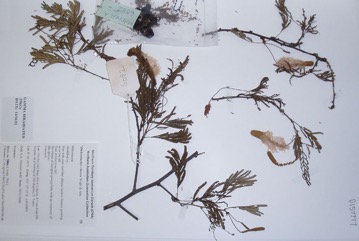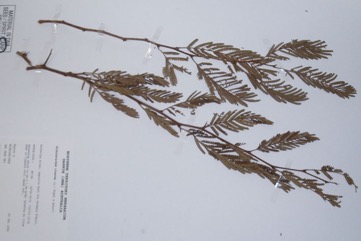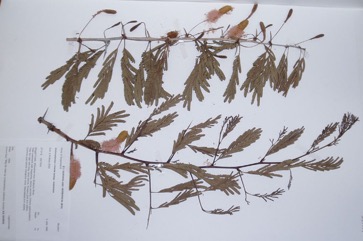Marabou Thorn, Sickle bush

A tropical plant. It is more common at low altitudes. In East Africa it grows between sea level and 1,700 m altitude. It grows on a range of soils in wooded grassland. It grows in the Sahel. It needs an annual rainfall between 200-400 mm. It can form thickets on poor soils. It will grow in most well-drained soils. It needs an open sunny position. It is damaged by frost but can tolerate some drought. It can grow in salty soils. It can grow in arid places.
Also known as:
Ader, Andera, Arzik, Bilatri, Bortuli, Chimphongala, Chipangala, Dhiigtaar, Evagia, Ithalala, Kansalonsalo, Katenge, Khairi, Kolai, Kudhu beli, Kunlai, Mkingiri, Moselesele, Muvilisya, Muwanika, N'talala, Odatare, Omutjete, Segum-kati, Sekelbos, Sitbyu, Tabe, Veltura, Vidattalai, Vurtuli
Synonyms
- Dichrostachys nutans (Pers.) Benth.
- Dichrostachys glomerata (Forsk.) Chiov.
- Dichrostachys nyassana Taub.
- Dichrostachys platycarpa Welw.
- Mimosa cinerea Linn.
- Mimosa glomerata Forsk
- Mimosa nutans Pers.
- Cailliea dichrostachys Guill. et Perrott.
- Calliea glomerata (Forssk.) J. F. Macbr. See Cailliea
Edible Portion
- Seeds, Pods, Fruit, Gum, Spice
Where does Marabou Thorn grow?
Found in: Africa, Angola, Asia, Australia, Benin, Botswana, Brunei, Burkina Faso, Burundi, Cambodia, Cameroon, Cape Verde, Central Africa, Central African Republic, CAR, Chad, China, Comoros, Congo, Côte d'Ivoire, Djibouti, East Africa, East Timor, Egypt, Eritrea, Eswatini, Ethiopia, Gabon, Gambia, Ghana, Guinea, Guinée, Guinea-Bissau, India, Indochina, Indonesia, Iran, Ivory Coast, Kenya, Laos, Lesotho, Liberia, Madagascar, Malawi, Malaysia, Maldives, Mali, Mauritania, Mozambique, Myanmar, Namibia, Niger, Nigeria, North Africa, Pakistan, Philippines, Rwanda, Sahel, Sao Tome and Principe, Saudi Arabia, SE Asia, Senegal, Seychelles, Sierra Leone, Somalia, South Africa, Southern Africa, South Sudan, Sri Lanka, Sudan, Swaziland, Tanzania, Thailand, Timor-Leste, Togo, Uganda, Vietnam, West Africa, Yemen, Zambia, Zimbabwe
Notes: There are about 15-20 Dichrostachys species. The leaves are used in medicine. Also as Mimosaceae.
Growing Marabou Thorn, Sickle bush
Cultivation: They can be grown from seed. The seed needs treatment before sowing. Hot water is poured over the seeds and left to soak for 24 hours before planting. Seeds germinate readily. Plants can be grown from root cuttings.
Edible Uses: The fruit and seeds are eaten. The seeds are used in soups. The gum is eaten as a snack.
Production: It grows slowly. In Central African Republic plants have been recorded flowering in June and July.
Nutrition Info
per 100g edible portion| Edible Part | Energy (kcal) | Protein (g) | Iron (mg) | Vitamin A (ug) | Vitamin c (mg) | Zinc (mg) | % Water |
|---|---|---|---|---|---|---|---|
| - | - | - | - | - | - |
Marabou Thorn, Sickle bush Photos



References
Abbiw, D.K., 1990, Useful Plants of Ghana. West African uses of wild and cultivated plants. Intermediate Technology Publications and the Royal Botanic Gardens, Kew. p 46
Ambasta, S.P. (Ed.), 2000, The Useful Plants of India. CSIR India. p 170, 94 (As Cailliea cinerea)
Ballal, M. E., et al, 2014, Ethno-botany of Natural Forests of Nuba Mountains, South Kordofan State, Sudan. Journal of Forest Poducts & Industries. 3(1):13-19
Bekele-Tesemma A., Birnie, A., & Tengnas, B., 1993, Useful Trees and Shrubs for Ethiopia. Regional Soil Conservation Unit. Technical Handbook No 5. p 186
Bodkin, F., 1991, Encyclopedia Botanica. Cornstalk publishing, p 339
Bonou, A., et al, 2013, Valeur economique des Produits Forestiers Non Ligneux (PFNL) au Benin. Editions Universitaires Europeennes p 98
Bouba, A. A., et al, 2012, Proximate Composition, Mineral and Vitamin Content of Some Wild Plants Used as Spices in Cameroon. Food and Nutrition Sciences 3:423-432.
Bunderson, W. T. et al, 2002, Common Agroforestry Species in Malawi. Malawi Agroforestry Extension Project, Pubication No. 46, Lilongwe. p 19
Burkill, H. M., 1985, The useful plants of west tropical Africa, Vol. 3. Kew.
Busson, 1965,
Chapman, J. D. & Chapman, H. M., 2001, The Forest Flora of Taraba and Andamawa States, Nigeria. WWF & University of Canterbury. p 183
Cowie, I, 2006, A Survey of Flora and vegetation of the proposed Jaco-Tutuala-Lore National Park. Timor-Lests (East Timor) www.territorystories.nt/gov.au p 50 (subsp. malesiana)
Dharani, N., 2002, Field Guide to common Trees & Shrubs of East Africa. Struik. p 222
Fowler, D. G., 2007, Zambian Plants: Their Vernacular Names and Uses. Kew. p 34
Grivetti, 1976, 1979,
Grivetti, L. E., 1980, Agricultural development: present and potential role of edible wild plants. Part 2: Sub-Saharan Africa, Report to the Department of State Agency for International Development. p 79
Jardin, C., 1970, List of Foods Used In Africa, FAO Nutrition Information Document Series No 2.p 25, 74, 132
Krishen P., 2006, Trees of Delhi, A Field Guide. DK Books. p 275
Lee, 1979,
Le Houerou, H. N., (Ed.), 1980, Browse in Africa. The current state of knowledge. International Livestock Centre for Africa, Ethiopia. p 163
Maydell, H. von, 1990, Trees and shrubs of the Sahel: their characteristics and uses. Margraf. p 251
Mbuya, L.P., Msanga, H.P., Ruffo, C.K., Birnie, A & Tengnas, B., 1994, Useful Trees and Shrubs for Tanzania. Regional Soil Conservation Unit. Technical Handbook No 6. p 232
Palgrave, K.C., 1996, Trees of Southern Africa. Struik Publishers. p 254
Peters, C. R., O'Brien, E. M., and Drummond, R.B., 1992, Edible Wild plants of Sub-saharan Africa. Kew. p 129
Pickering, H., & Roe, E., 2009, Wild Flowers of the Victoria Falls Area. Helen Pickering, London. p 73
Prodr. fl. Ind. orient. 271. 1834
Roodt, V., 1998, Trees & Shrubs of the Okavango Delta. Medicinal Uses and Nutritional value. The Shell Field Guide Series: Part 1. Shell Botswana. p 181 (subsp. africana)
Royal Botanic Gardens, Kew (1999). Survey of Economic Plants for Arid and Semi-Arid Lands (SEPASAL) database. Published on the Internet; http://www.rbgkew.org.uk/ceb/sepasal/internet [Accessed 28th April 2011]
Ruiters-Welcome, A. K., 2019, Food plants of southern Africa. Ph.D. thesis. Univ. of Johannesburg p 57
Storrs, A. E. C., 1995 reprint, Know Your Trees. Some Common Trees found in Zambia, Forestry Division. Regional Soil Conservation Unit, Nairobi, p 55
Sujanapal, P., & Sankaran, K. V., 2016, Common Plants of Maldives. FAO & Kerala FRI, p 112
Sukarya, D. G., (Ed.) 2013, 3,500 Plant Species of the Botanic Gardens of Indonesia. LIPI p 228
Swaziland's Flora Database http://www.sntc.org.sz/flora (Subsp. africana)
Tebkew, M. et al, 2014, Underutilized wild edible plants in the Chilga District, northwestern Ethiopia: focus on wild woody plants. Agriculture & Food Security 3:12
Tebkew, M., et al, 2018, Uses of wild edible plants in Quara district, northwest Ethiopia: implication for forest management. Agriculture and Food Security (2018) 7:12
van Wyk, B, van Wyk, P, and van Wyk B., 2000, Photographic guide to Trees of Southern Africa. Briza. p 117
van Wyk, Ben-Erik, 2019, The diversity and multiple uses of southern African legumes. Australian Systematic Botany, 2019, 32, 519–546
Williamson, J., 2005, Useful Plants of Malawi. 3rd. Edition. Mdadzi Book Trust. p 97
World Checklist of Useful Plant Species 2020. Royal Botanic Gardens, Kew
www.worldagroforestrycentre.org/sea/products/afdbases/af/asp/SpeciesInfo.asp?SpID=675
Yerima, B. J. & Kanawa, A. A., 2018, Nutritive Mineral Content of Dichrostachy cinerea (Sickle bush) Seeds and Fruits. Chemistry Research Journal, 2018, 3(3):168-178